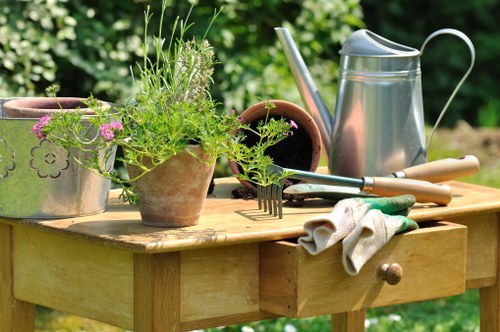Mastering Hedge Trimming in Deptford: Your Comprehensive Guide
Introduction to Hedge Trimming

Hedge trimming is an essential aspect of garden maintenance, ensuring that hedges remain healthy, aesthetically pleasing, and well-shaped. In Deptford, where gardens are a significant part of many homes, mastering hedge trimming can transform outdoor spaces into beautiful retreats.
Whether you're a seasoned gardener or a beginner, understanding the techniques and best practices of hedge trimming can make a substantial difference in your garden's appearance and health.
In this guide, we'll explore everything you need to know about hedge trimming in Deptford, from the tools you'll need to the specific techniques that yield the best results.
Why Hedge Trimming Matters

Hedge trimming isn't just about aesthetics; it's also crucial for the health of the plants. Regular trimming helps to:
- Promote Growth: Trimming encourages new growth, making your hedges fuller and healthier.
- Maintain Shape: Regular cuts ensure that hedges retain their desired shape and size.
- Prevent Disease: Removing dead or diseased branches helps prevent the spread of infections.
- Enhance Curb Appeal: Well-maintained hedges enhance the overall look of your property.
In Deptford's climate, where weather conditions can vary, timely hedge trimming can help plants withstand environmental stresses.
Moreover, with the increasing focus on sustainable gardening, proper hedge maintenance aligns with eco-friendly practices by promoting plant health and reducing the need for pesticides.
Essential Tools for Hedge Trimming

Having the right tools is fundamental to effective hedge trimming. Here are the essential tools you should consider:
- Hedge Trimmers: Available in manual, electric, and gas-powered versions, hedge trimmers are the primary tool for shaping hedges.
- Pruning Shears: For more precise cuts, especially on smaller branches.
- Loppers: Useful for thicker branches that trimmers and shears can't handle.
- Gloves: Protect your hands from thorns, insects, and debris.
- Safety Goggles: Protect your eyes from flying debris during trimming.
Investing in high-quality tools not only makes the trimming process easier but also ensures better results and longevity of your equipment.
Regular maintenance of your tools, such as sharpening blades and cleaning, will enhance their performance and lifespan.
Best Time for Hedge Trimming in Deptford

Timing is crucial when it comes to hedge trimming. In Deptford, the best times to trim hedges are:
- Late Spring: After the first growth surge, typically in May, to encourage bushier growth.
- Late Summer: Around August, to tidy up the hedges before winter sets in.
Avoid trimming in late autumn or winter, as this can stress the plants and make them more susceptible to cold damage.
Additionally, be mindful of the specific needs of different hedge species, as some may have unique trimming requirements.
Step-by-Step Hedge Trimming Guide

Follow these steps to achieve professional-looking hedges:
- Assess the Hedges: Examine the current state and decide on the desired shape and height.
- Prepare Your Tools: Ensure all tools are clean and sharpened.
- Start Trimming: Begin with the outer edges, working your way inward for an even shape.
- Maintain Consistency: Keep your cuts uniform to ensure the hedge grows evenly.
- Clean Up: Remove all trimmings to prevent disease and pests.
For intricate designs, take your time and make small, precise cuts. Remember, it's easier to trim more if needed than to fix over-trimmed hedges.
Regular maintenance between major trimming sessions will help keep your hedges in top condition.
Common Hedge Trimming Mistakes to Avoid
Even with the best intentions, some common mistakes can undermine your hedge trimming efforts. Avoid the following:
- Over-Trimming: Removing too much can stress the plant and hinder growth.
- Ignoring Plant Health: Trimming diseased branches without addressing the underlying issues can spread infections.
- Using Dull Tools: Dull blades can cause jagged cuts, leading to poor healing and increased vulnerability to pests.
- Trimming at the Wrong Time: As mentioned, trimming during cold months can damage the plants.
By being aware of these pitfalls, you can ensure that your hedge trimming efforts lead to healthy, beautiful hedges.
Continuous learning and practice will help you refine your trimming techniques over time.
Choosing the Right Hedge Trimming Service in Deptford
If you prefer professional assistance, selecting the right hedge trimming service in Deptford is crucial. Consider the following factors:
- Experience: Look for services with a proven track record and expertise in hedge trimming.
- Reputation: Check reviews and testimonials to gauge customer satisfaction.
- Pricing: Compare quotes to ensure you're getting quality service at a fair price.
- Insurance: Ensure the service is insured to protect against any potential damages.
- Service Offerings: Some services may offer additional landscaping or garden maintenance options.
Choosing a reputable service ensures that your hedges are trimmed professionally, saving you time and effort while achieving the best results.
Don't hesitate to ask for references or examples of previous work to make an informed decision.
Maintaining Your Hedges Post-Trimming
After a successful trimming session, proper maintenance is essential to keep your hedges thriving:
- Watering: Ensure your hedges receive adequate water, especially during dry spells.
- Fertilizing: Use appropriate fertilizers to provide necessary nutrients.
- Pest Control: Monitor for pests and treat promptly to prevent infestations.
- Regular Inspections: Check your hedges regularly for signs of disease or damage.
By maintaining your hedges, you ensure their longevity and beauty, making future trimming sessions easier and more effective.
Consistency in care is key to achieving a lush and healthy hedge.
Eco-Friendly Hedge Trimming Practices
Sustainability is increasingly important in gardening. Here are some eco-friendly practices for hedge trimming:
- Using Manual Tools: Opt for manual trimmers to reduce carbon emissions.
- Recycling Trimmings: Compost the clippings to enrich your garden soil.
- Selecting Native Plants: Choose hedge species native to Deptford to support local biodiversity.
- Water Conservation: Implement efficient watering systems to minimize water usage.
Incorporating these practices not only benefits the environment but also promotes a healthier garden ecosystem.
Adopting sustainable techniques can make your garden a model of eco-friendly landscaping.
Advanced Hedge Trimming Techniques
For those looking to elevate their hedge trimming skills, consider these advanced techniques:
- Topiary: Creating intricate shapes and designs using precise trimming.
- Espalier: Training hedges to grow flat against a structure for space efficiency.
- Layered Trimming: Shaping hedges in layers to add depth and dimension.
These techniques require practice and patience but can result in stunning visual effects that enhance your garden's appeal.
Invest time in learning these methods to create unique and personalized landscape features.
Conclusion
Hedge trimming in Deptford is both an art and a science, requiring the right tools, techniques, and timing. Whether you choose to undertake this task yourself or hire a professional service, the key is consistent care and attention.
By following the guidelines outlined in this article, you can ensure that your hedges remain healthy, beautiful, and a standout feature of your garden.
Ready to transform your garden? Contact us today to book your hedge trimming service and take the first step towards a more beautiful outdoor space.
